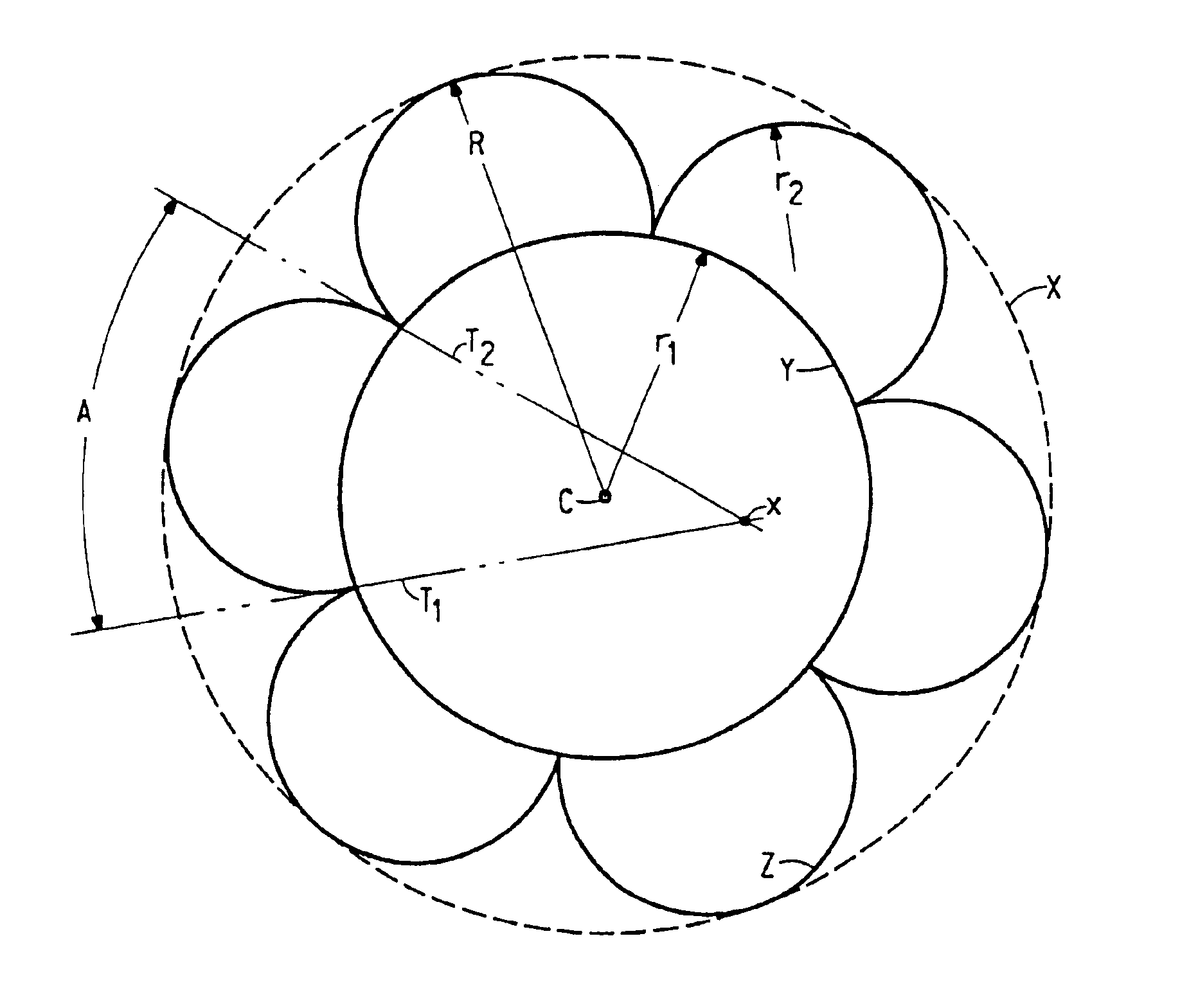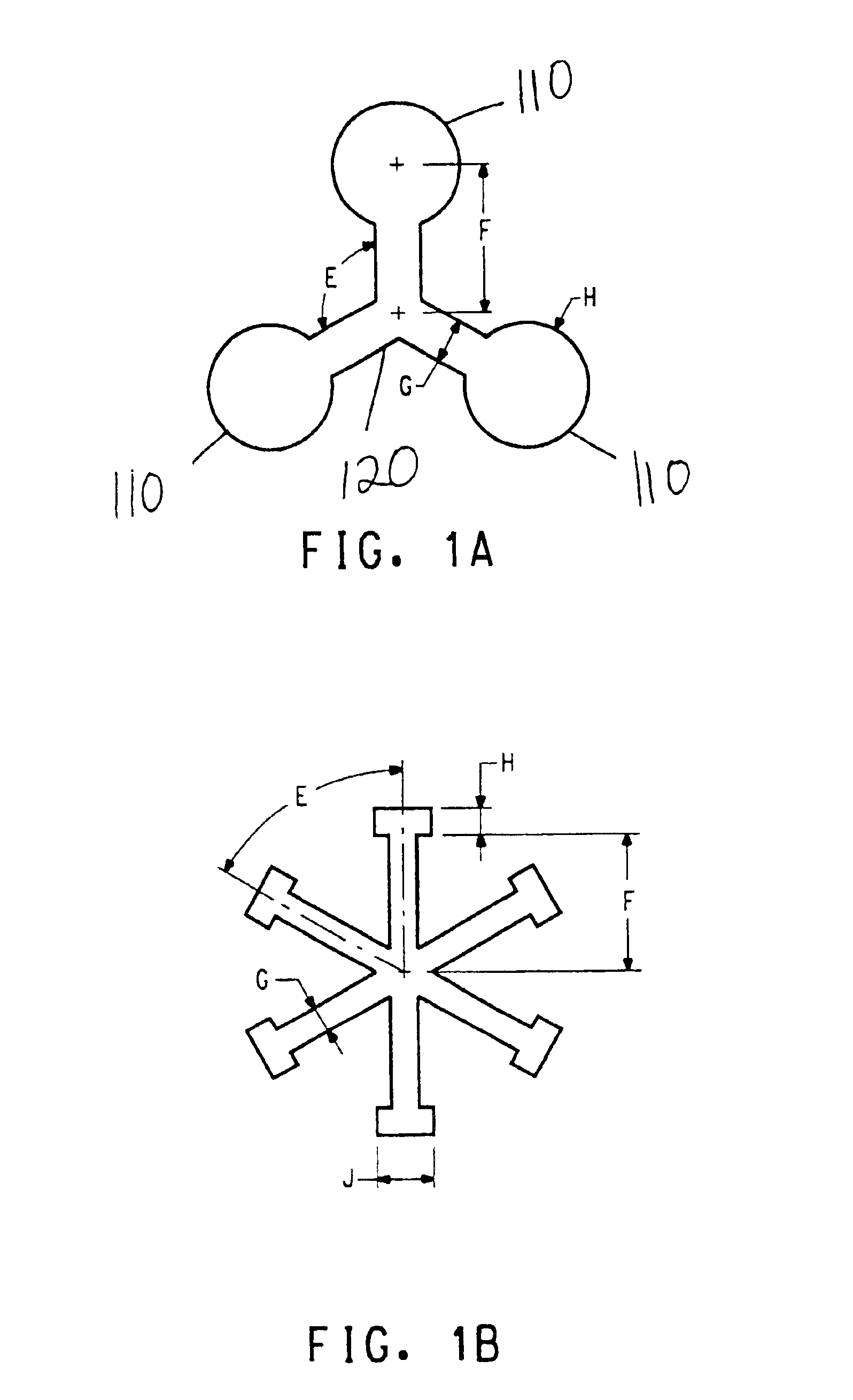Multilobal polymer filaments and articles produced therefrom
a polymer filament and multi-lobal technology, applied in the field of synthetic polymer filaments, can solve the problems of unsatisfactory glittering or sparkle, filaments described in these patents still need to be textured, and cannot provide a means to reduce glitter of fine denier and especially subdenier filaments, so as to reduce glitter in fabrics
- Summary
- Abstract
- Description
- Claims
- Application Information
AI Technical Summary
Benefits of technology
Problems solved by technology
Method used
Image
Examples
example i
Yarns of 100 fine filaments of nominal 1.15 dpf were spun from poly(ethylene terephthalate) of nominal 21.7 LRV (lab relative viscosity) and containing 0.3 weight percent TiO2. The spinning process was essentially as described in U.S. Pat. No. 5,250,245 and U.S. Pat. No. 5,288,553 and using a radial quench apparatus having a delay “shroud” length (LDQ) of about 1.7 inches (4.3 cm). Example I-1 yarn was comprised of 3-lobe filaments of the invention having filament cross-sections in appearance similar to FIG. 2A, and was made using 100-capillary spinnerets using 9 mil (0.229 mm) diameter×36 mil (0.914 mm) length metering capillaries and spinneret exit orifices having three slots centrally-joined and projecting radially; slot center lines being separated by 120 degrees (E) as set forth in FIG. 1A. Each slot had the following geometry: 1.7 mil (0.043 mm) slot width (G), having a 5 mil (0.127 mm) diameter circular enlargement (H) at the end of each slot, the center of said circular enla...
example ii
Yarns comprised of fine filaments of nominal 1.24 dpf and 3-lobe cross-sections were spun at 2675 ypm (2446 meters / minute), essentially as described in Example I-1; 100-filament yarn bundles were combined prior to takeup to produce 200-filament yarn bundles. Example II-1 yarn was comprised of fine multilobal filaments of the invention, having average filament factor of 2.37; average lobe angle was −35.4 degrees, having filament cross-sections similar in appearance to FIG. 2A. Comparative Example II-A yarn was comprised of fine trilobal filaments not of the invention, having average filament factor of 0.77; average lobe angle was +18.6 degrees, having filament cross-sections similar in appearance to FIG. 9. Comparative Example II-B was a unitary 200-filament yarn as described in U.S. Pat. No. 5,741,587 and U.S. Pat. No. 5,827,464 and having round cross-section filaments. Physical properties and cross section parameters of the as-spun yarns are listed in Table II-1.
Yarns II-1, II-A, a...
example iii
Yarns comprised of fine filaments of nominal 1.4 dpf and 3-lobes were produced essentially as described in Example II, except that 88-filament yarn bundles were combined prior to takeup to produce 176-filament yarn bundles. Examples III-1 and III-2 yarns were comprised of fine 3-lobe filaments having average filament factor of ≧2 and having cross-sections in appearance similar to FIG. 2A. The polymer of Example III-1 contained 1.0% TiO2 and was of nominal 20.2 LRV, whereas the polymer of Example III-2 contained 0.30% TiO2 and was of nominal 21.7 LRV. Comparative Example III-A polymer contained 1.5% TiO2 and was of nominal 20.6 LRV, and the Comparative Example III-A yarn was comprised of round filaments. The spinning speed of each Example III-1, III-2, and III-A was adjusted to achieve a draw tension of about 0.45 grams / denier. Physical properties and cross section parameters of the as-spun yarns are listed in Table III-1.
Yarns III-1, III-2, and III-A were draw false-twist textured u...
PUM
| Property | Measurement | Unit |
|---|---|---|
| Angle | aaaaa | aaaaa |
| Shrinkage | aaaaa | aaaaa |
| Shrinkage | aaaaa | aaaaa |
Abstract
Description
Claims
Application Information
 Login to View More
Login to View More - R&D
- Intellectual Property
- Life Sciences
- Materials
- Tech Scout
- Unparalleled Data Quality
- Higher Quality Content
- 60% Fewer Hallucinations
Browse by: Latest US Patents, China's latest patents, Technical Efficacy Thesaurus, Application Domain, Technology Topic, Popular Technical Reports.
© 2025 PatSnap. All rights reserved.Legal|Privacy policy|Modern Slavery Act Transparency Statement|Sitemap|About US| Contact US: help@patsnap.com



